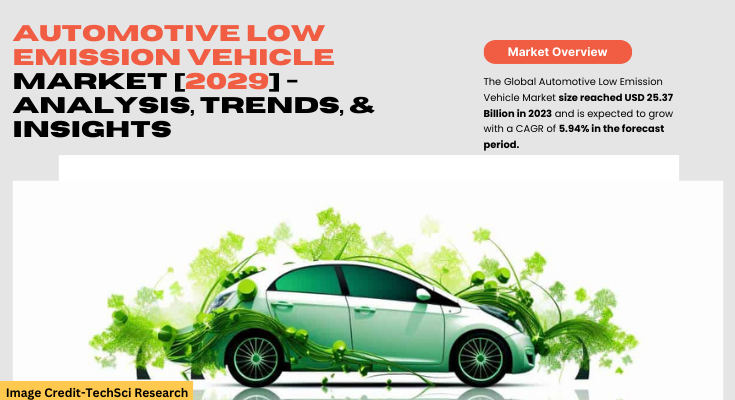According to TechSci Research report, “Automotive Low Emission Vehicle Market – Global Industry Size, Share, Trends, Competition Forecast & Opportunities, 2029”, the Global Automotive Low Emission Vehicle Market stood at USD 25.37 Billion in 2023 and is anticipated to grow with a CAGR of 5.94% in the forecast period, 2025-2029. The automotive low emission vehicle market represents a significant shift in the automotive industry towards environmentally friendly and sustainable transportation solutions. Low emission vehicles, also known as green vehicles or eco-friendly vehicles, are designed to minimize harmful emissions of greenhouse gases and pollutants, such as carbon dioxide (CO2), nitrogen oxides (NOx), and particulate matter, that contribute to air pollution and climate change. These vehicles employ various technologies and alternative fuels to reduce their environmental impact and promote cleaner air quality.
One of the primary drivers of the automotive low emission vehicle market is the increasing global concern over climate change and air pollution. Governments, regulatory bodies, and environmental organizations worldwide are implementing stricter emissions standards and regulations to reduce vehicle emissions and combat the adverse effects of climate change. In response to these regulations, automakers are developing and manufacturing low emission vehicles that meet or exceed stringent emission standards, such as Euro 6, EPA Tier 3, and China 6, to minimize their environmental footprint.
Moreover, advancements in automotive technology and innovation have led to the development of low emission vehicles powered by alternative fuels and propulsion systems. Electric vehicles (EVs), hybrid electric vehicles (HEVs), plug-in hybrid electric vehicles (PHEVs), and fuel cell electric vehicles (FCEVs) are gaining popularity as viable alternatives to traditional internal combustion engine vehicles. These vehicles utilize electric motors, batteries, hydrogen fuel cells, or a combination of both to propel the vehicle and significantly reduce or eliminate tailpipe emissions.
Additionally, the automotive low emission vehicle market is driven by consumer demand for cleaner and more sustainable transportation options. Increasing awareness of environmental issues, rising fuel costs, and government incentives and subsidies for low emission vehicles are encouraging consumers to consider green vehicles as a viable alternative to conventional gasoline or diesel-powered vehicles. The availability of a wide range of low emission vehicle models across various vehicle segments, including passenger cars, SUVs, and commercial vehicles, further contributes to the market’s growth and adoption.
Furthermore, the automotive low emission vehicle market is characterized by ongoing research and development efforts to further improve vehicle efficiency, reduce emissions, and enhance the performance and affordability of low emission vehicles. Automakers are investing in battery technology, lightweight materials, aerodynamics, and other innovations to extend the range and capabilities of electric vehicles, improve fuel economy in hybrid vehicles, and develop sustainable fuel alternatives for internal combustion engines. These advancements are driving the evolution of the automotive industry towards a more sustainable and environmentally responsible future.
Browse over market data Figures spread through XX Pages and an in-depth TOC on “ Global Automotive Low Emission Vehicle Market.” @ https://www.techsciresearch.com/report/automotive-low-emission-vehicle-market/21168.html
The automotive low emission vehicle (LEV) market is witnessing growth across various regions, including Asia Pacific, North America, Europe & CIS, South America, and the Middle East & Africa. Low emission vehicles are gaining traction globally due to increasing environmental concerns, stringent emission regulations, and growing consumer awareness about the benefits of reducing carbon emissions.
In the Asia Pacific region, which comprises countries like China, Japan, India, and South Korea, the automotive LEV market is experiencing significant growth. Governments in these countries are implementing strict emission standards and offering incentives to promote the adoption of low emission vehicles. Additionally, rising urbanization, increasing disposable incomes, and growing environmental consciousness among consumers are driving the demand for LEVs in the region.
North America is another key market for automotive low emission vehicles, with the United States and Canada leading the way. The region has witnessed a surge in the adoption of electric vehicles (EVs) and hybrid vehicles due to government incentives, environmental regulations, and consumer preferences for eco-friendly transportation options. Moreover, automakers in North America are investing in research and development to develop advanced LEV technologies, further boosting market growth.
In Europe & CIS, countries like Germany, France, and Russia are witnessing a growing demand for low emission vehicles. The European Union has set ambitious emission reduction targets, leading to increased investments in electric and hybrid vehicles. Governments are offering subsidies, tax incentives, and infrastructure support to encourage the adoption of LEVs. Additionally, the development of charging infrastructure and advancements in battery technology are driving market growth in the region.
South America presents a growing market for automotive low emission vehicles, with countries like Brazil, Argentina, and Chile witnessing increasing adoption. The region is focusing on reducing carbon emissions and promoting sustainable transportation solutions. Government initiatives, such as tax incentives for electric vehicles and investment in charging infrastructure, are driving the demand for LEVs in South America.
The Middle East & Africa region is also witnessing a gradual shift towards low emission vehicles, albeit at a slower pace compared to other regions. Countries like the United Arab Emirates, Saudi Arabia, and South Africa are exploring options to reduce dependency on fossil fuels and promote cleaner transportation alternatives. However, challenges such as limited infrastructure and consumer awareness hinder the rapid adoption of LEVs in the region.
Overall, the global automotive low emission vehicle market is characterized by growth across multiple regions, driven by factors such as stringent emission regulations, government incentives, technological advancements, and increasing consumer awareness about environmental sustainability. While each region presents unique opportunities and challenges, the automotive industry is expected to continue transitioning towards low emission vehicles to mitigate climate change and reduce air pollution.
Major companies operating in the Global Automotive Low Emission Vehicle Market are:
- Toyota Motors
- Tesla Motors
- Honda Motors
- Skoda Motors
- Mitsubishi Motors
- General Motors
- Nissan Motors
- Ford Motor Company
- BMW Group
- Hyundai Motor Group
Download Free Sample Report @ https://www.techsciresearch.com/sample-report.aspx?cid=21168
Customers can also request 10% free customization in this report.
“In the Global Automotive Low Emission Vehicle Market, a transformative trajectory driven by an increasing convergence of technological innovation and regulatory imperatives. The push toward electric and hybrid vehicles is seen as an irreversible trend, with a growing consensus that these sustainable mobility solutions are not only essential for environmental stewardship but also present substantial business opportunities for automakers. As charging infrastructure expands, battery technology improves, and governments intensify emissions targets, experts anticipate a paradigm shift in consumer preferences and industry dynamics towards a greener and more sustainable automotive future,” said Mr. Karan Chechi, Research Director with TechSci Research, a research-based management consulting firm.
“Automotive Low Emission Vehicle Market – Global Industry Size, Share, Trends Opportunity, and Forecast, Segmented By Degree of Hybridization (EV, HEV, MHEV, PHEV), By Battery Type (Metal Hydride, Lithium Ion, Nickel Cadmium, Lead Acid), By Vehicle Type (Passenger Cars, LCV, M&HCV), By Region, Competition, 2019-2029”, has evaluated the future growth potential of Global Automotive Low Emission Vehicle Market and provides statistics & information on market size, structure, and future market growth. The report intends to provide cutting-edge market intelligence and help decision makers take sound investment decisions. Besides, the report also identifies and analyzes the emerging trends along with essential drivers, challenges, and opportunities in the Global Automotive Low Emission Vehicle Market.
You may also read:
Luxury Yacht Market [2029] Exploring Potential, Growth, Future & Trends
All Weather Tire Market [2029] – Analysis, Trends, & Insights
Electric Bus Charging Infrastructure Market Advancements and Business Opportunities [2029]
Automotive Steering Knuckle Market – A Comprehensive Report [2029]
Electric Cargo Bikes Market [2029] Exploring Potential, Growth, Future & Trends
Electric Truck Market [2029]- A Deep Dive into the Latest Market Trends, Market Segmentation
Table of Content-Automotive Low Emission Vehicle Market
- Introduction
1.1. Product Overview
1.2. Key Highlights of the Report
1.3. Market Coverage
1.4. Market Segments Covered
1.5. Research Tenure Considered
- Research Methodology
2.1. Objective of the Study
2.2. Baseline Methodology
2.3. Key Industry Partners
2.4. Major Association and Secondary Sources
2.5. Forecasting Methodology
2.6. Data Triangulation & Validation
2.7. Assumptions and Limitations
- Executive Summary
3.1. Market Overview
3.2. Market Forecast
3.3. Key Regions
3.4. Key Segments
- Impact of COVID-19 on Global Automotive Low Emission Vehicle Market
- Global Automotive Low Emission Vehicle Market Outlook
5.1. Market Size & Forecast
5.1.1. By Value
5.2. Market Share & Forecast
5.2.1. By Degree of Hybridization Market Share Analysis (EV, HEV, MHEV, PHEV)
5.2.2. By Battery Type Market Share Analysis (Metal Hydride, Lithium Ion, Nickel Cadmium, Lead Acid)
5.2.3. By Vehicle Type Market Share Analysis (Passenger Cars, LCV, M&HCV)
5.2.4. By Regional Market Share Analysis
5.2.4.1. Asia-Pacific Market Share Analysis
5.2.4.2. Europe & CIS Market Share Analysis
5.2.4.3. North America Market Share Analysis
5.2.4.4. South America Market Share Analysis
5.2.4.5. Middle East & Africa Market Share Analysis
5.2.5. By Company Market Share Analysis (Top 5 Companies, Others – By Value, 2023)
5.3. Global Automotive Low Emission Vehicle Market Mapping & Opportunity Assessment
5.3.1. By Degree of Hybridization Market Mapping & Opportunity Assessment
5.3.2. By Battery Type Market Mapping & Opportunity Assessment
5.3.3. By Vehicle Type Market Mapping & Opportunity Assessment
5.3.4. By Regional Market Mapping & Opportunity Assessment
- Asia-Pacific Automotive Low Emission Vehicle Market Outlook
6.1. Market Size & Forecast
6.1.1. By Value
6.2. Market Share & Forecast
6.2.1. By Degree of Hybridization Market Share Analysis
6.2.2. By Battery Type Market Share Analysis
6.2.3. By Vehicle Type Market Share Analysis
6.2.4. By Country Market Share Analysis
6.2.4.1. China Market Share Analysis
6.2.4.2. India Market Share Analysis
6.2.4.3. Japan Market Share Analysis
6.2.4.4. Indonesia Market Share Analysis
6.2.4.5. Thailand Market Share Analysis
6.2.4.6. South Korea Market Share Analysis
6.2.4.7. Australia Market Share Analysis
6.2.4.8. Rest of Asia-Pacific Market Share Analysis
6.3. Asia-Pacific: Country Analysis
6.3.1. China Automotive Low Emission Vehicle Market Outlook
6.3.1.1. Market Size & Forecast
6.3.1.1.1. By Value
6.3.1.2. Market Share & Forecast
6.3.1.2.1. By Degree of Hybridization Market Share Analysis
6.3.1.2.2. By Battery Type Market Share Analysis
6.3.1.2.3. By Vehicle Type Market Share Analysis
6.3.2. India Automotive Low Emission Vehicle Market Outlook
6.3.2.1. Market Size & Forecast
6.3.2.1.1. By Value
6.3.2.2. Market Share & Forecast
6.3.2.2.1. By Degree of Hybridization Market Share Analysis
6.3.2.2.2. By Battery Type Market Share Analysis
6.3.2.2.3. By Vehicle Type Market Share Analysis
6.3.3. Japan Automotive Low Emission Vehicle Market Outlook
6.3.3.1. Market Size & Forecast
6.3.3.1.1. By Value
6.3.3.2. Market Share & Forecast
6.3.3.2.1. By Degree of Hybridization Market Share Analysis
6.3.3.2.2. By Battery Type Market Share Analysis
6.3.3.2.3. By Vehicle Type Market Share Analysis




